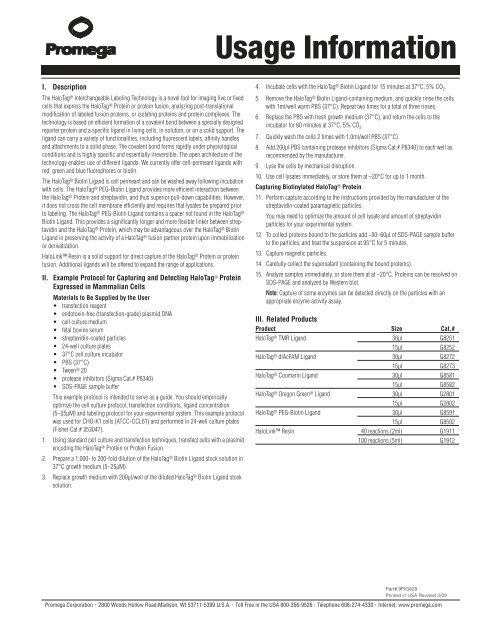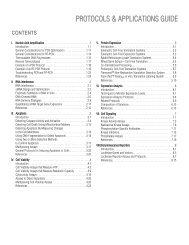Create successful ePaper yourself
Turn your PDF publications into a flip-book with our unique Google optimized e-Paper software.
I. Description<br />
The HaloTag ® Interchangeable Labeling Technology is a novel tool for imaging live or fixed<br />
cells that express the HaloTag ® Protein or protein fusion, analyzing post-translational<br />
modification of labeled fusion proteins, or isolating proteins and protein complexes. The<br />
technology is based on efficient formation of a covalent bond between a specially designed<br />
reporter protein and a specific ligand in living cells, in solution, or on a solid support. The<br />
ligand can carry a variety of functionalities, including fluorescent labels, affinity handles<br />
and attachments to a solid phase. The covalent bond forms rapidly under physiological<br />
conditions and is highly specific and essentially irreversible. The open architecture of the<br />
technology enables use of different ligands. We currently offer cell-permeant ligands with<br />
red, green and blue fluorophores or biotin.<br />
The HaloTag ® Biotin Ligand is cell permeant and can be washed away following incubation<br />
with cells. The HaloTag ® PEG-Biotin Ligand provides more efficient interaction between<br />
the HaloTag ® Protein and streptavidin, and thus superior pull-down capabilities. However,<br />
it does not cross the cell membrane efficiently and requires that lysates be prepared prior<br />
to labeling. The HaloTag ® PEG-Biotin Ligand contains a spacer not found in the HaloTag ®<br />
Biotin Ligand. This provides a significantly longer and more flexible linker between streptavidin<br />
and the HaloTag ® Protein, which may be advantageous over the HaloTag ® Biotin<br />
Ligand in preserving the activity of a HaloTag ® fusion partner protein upon immobilization<br />
or derivatization.<br />
HaloLink Resin is a solid support for direct capture of the HaloTag ® Protein or protein<br />
fusion. Additional ligands will be offered to expand the range of applications.<br />
II. Example <strong>Protocol</strong> for Capturing and Detecting HaloTag ® Protein<br />
Expressed in Mammalian Cells<br />
Materials to Be Supplied by the User<br />
transfection reagent<br />
endotoxin-free (transfection-grade) plasmid DNA<br />
cell culture medium<br />
fetal bovine serum<br />
streptavidin-coated particles<br />
24-well culture plates<br />
37°C cell culture incubator<br />
PBS (37°C)<br />
Tween ® 20<br />
protease inhibitors (Sigma Cat.# P8340)<br />
SDS-PAGE sample buffer<br />
This example protocol is intended to serve as a guide. You should empirically<br />
optimize the cell culture protocol, transfection conditions, ligand concentration<br />
(5–25µM) and labeling protocol for your experimental system. This example protocol<br />
was used for CHO-K1 cells (ATCC-CCL61) and performed in 24-well culture plates<br />
(Fisher Cat.# 353047).<br />
1. Using standard cell culture and transfection techniques, transfect cells with a plasmid<br />
encoding the HaloTag ® Protein or Protein Fusion.<br />
2. Prepare a 1,000- to 200-fold dilution of the HaloTag ® Biotin Ligand stock solution in<br />
37°C growth medium (5–25µM).<br />
3. Replace growth medium with 200µl/well of the diluted HaloTag ® Biotin Ligand stock<br />
solution.<br />
Usage Information<br />
4. Incubate cells with the HaloTag ® Biotin Ligand for 15 minutes at 37°C, 5% CO2 .<br />
5. Remove the HaloTag ® Biotin Ligand-containing medium, and quickly rinse the cells<br />
with 1ml/well warm PBS (37°C). Repeat two times for a total of three rinses.<br />
6. Replace the PBS with fresh growth medium (37°C), and return the cells to the<br />
incubator for 60 minutes at 37°C, 5% CO2 .<br />
7. Quickly wash the cells 2 times with 1.0ml/well PBS (37°C).<br />
8. Add 200µl PBS containing protease inhibitors (Sigma Cat.# P8340) to each well as<br />
recommended by the manufacturer.<br />
9. Lyse the cells by mechanical disruption.<br />
10. Use cell lysates immediately, or store them at –20°C for up to 1 month.<br />
Capturing Biotinylated HaloTag ® Protein<br />
11. Perform capture according to the instructions provided by the manufacturer of the<br />
streptavidin-coated paramagnetic particles.<br />
You may need to optimize the amount of cell lysate and amount of streptavidin<br />
particles for your experimental system.<br />
12. To collect proteins bound to the particles add ~50–60µl of SDS-PAGE sample buffer<br />
to the particles, and heat the suspension at 95°C for 5 minutes.<br />
13. Capture magnetic particles.<br />
14. Carefully collect the supernatant (containing the bound proteins).<br />
15. Analyze samples immediately, or store them at at –20°C. Proteins can be resolved on<br />
SDS-PAGE and analyzed by Western blot.<br />
Note: Capture of some enzymes can be detected directly on the particles with an<br />
appropriate enzyme activity assay.<br />
III. Related Products<br />
Product Size Cat.#<br />
HaloTag ® TMR Ligand 30µl G8251<br />
15µl G8252<br />
HaloTag ® diAcFAM Ligand 30µl G8272<br />
15µl G8273<br />
HaloTag ® Coumarin Ligand 30µl G8581<br />
15µl G8582<br />
HaloTag ® Oregon Green ® Ligand 30µl G2801<br />
15µl G2802<br />
HaloTag ® PEG-Biotin Ligand 30µl G8591<br />
15µl G8592<br />
HaloLink Resin 40 reactions (2ml) G1911<br />
100 reactions (5ml) G1912<br />
Part# 9PIG828<br />
Printed in USA Revised 2/09<br />
<strong>Promega</strong> Corporation · 2800 Woods Hollow Road·Madison, WI 53711-5399 U.S.A. · Toll Free in the USA 800-356-9526 · Telephone 608-274-4330 · Internet: www.promega.com
















